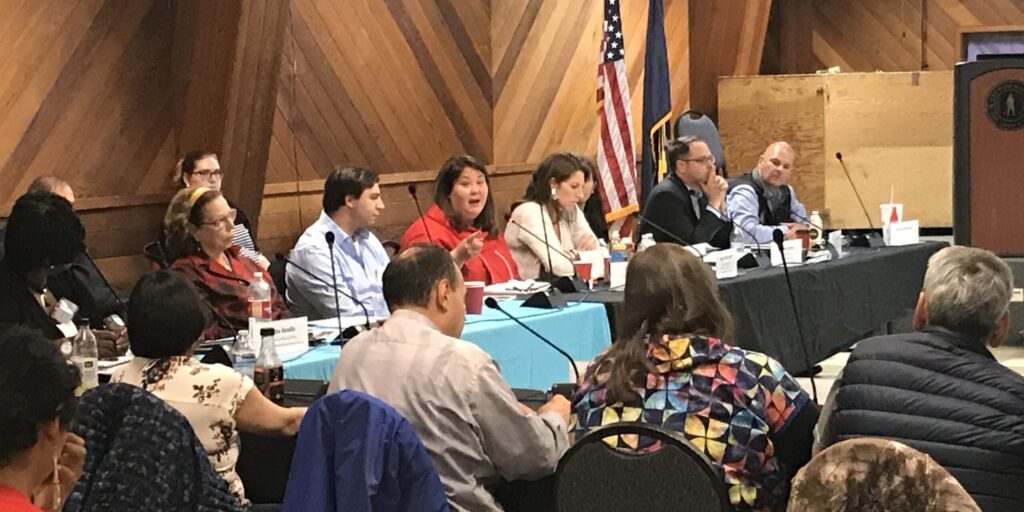Tara Sweeney, Assistant Secretary for Indian Affairs at the U.S. Department of the Interior, visited Nome on Monday for an event called “Reclaiming Our Native Communities”: a roundtable discussion on public safety hosted by Kawerak. The primary agenda included discussion on violent crime, missing and murdered Native Americans, and narcotics.
The events were closed to the media to facilitate “honest conversation,” but KNOM’s Emily Hofstaedter was able to speak with Sweeney and other officials from the White House and Bureau of Indian Affairs, who were part of the conversation.
Sweeney sees events like the one on Monday as opportunities for “partnership” between entities like hers and local communities.
“… to listen to community leaders, advocates, to discuss issues on how we can arrest the statistics on violent crimes, sexual abuse, domestic violence, and missing and murdered Native Americans in our communities.”
While the press was not allowed to attend, Sweeney said Kawerak invited tribal representatives from the area, victim advocates, health experts, and law enforcement.
This is the first event of its kind that the Department of the Interior, White House, and Bureau of Indian Affairs are doing in Alaska. But they have begun to do similar community discussions in Arizona and Oregon, and plan on doing more nationwide in areas with high concentrations of missing and murdered Native people.
“Right now, we think that improving data and working with the communities and getting accurate data will give us a good picture of what it is we are trying to solve.”
Kate MacGregor is the deputy Chief of Staff, exercising authority for Deputy Secretary, for the Department of the Interior. She says she’s noticed in previous conversations that communities aren’t always aware of the resources available to them. Tribes sometimes have their own databases for tracking missing people but might not realize there is a federal database, too: the National Missing and Unidentified Person System, or “NaMUS.” MacGregor says that getting those entities to communicate to each other is crucial.
“We’d like to move in partnership, and it’s always helpful to sit and spend time with these communities and hear what their opinions are and what they’d like to see in their communities when it comes to a smart solution and leveraging the assets the federal government has.”
MacGregor says that, early this winter, when the Department of the Interior visited Gila River, Arizona, 116 names entered into NaMUS were identified as American Indian or Alaska Native.
“About three people jumped up from the table and said, ‘That’s wrong!’”
MacGregor says that, now, more people are making use of that database, which is connected to the Department of Justice and FBI. Today, the number of people in NaMUS who are identified as American Indian or Alaska Native is at 400.
BIA Office of Justice Services Director Charles Addington says that NaMUS is now working to add more specific tribal data fields into their system in order to input more information for missing and murdered people.
Addington has worked in “Indian Country” law enforcement for twenty-five years. He says that tribes have been outspoken in their public safety issues, like a lack of law enforcement, and lack of justice for missing people:
“We keep hearing from tribal leaders, ‘We need help! We need help!’ And I think this show of concern for the problem and actually trying to bring a solution to the table is just paramount of getting some type of public safety services throughout the nation to address the problem.”
These talks come after Attorney General William Barr visited Western Alaska earlier this summer and subsequently declared a “public safety state of emergency.” Last month, the state Department of Public Safety received $6 million in federal funding for Alaska Native communities to use for law enforcement projects.
Right now, assistant secretary Sweeney says the BIA and Department of Interior don’t have concrete ideas for policy-making or plans to issue funding to support specific projects.
“We’re going to continue to use these listening sessions as an opportunity to inform our internal discussions on what we would like to propose as policy solutions so we’re not coming here with a pre-baked idea. We want to hear from communities.”
They plan to meet with Calista Corporation and the Association of Village Council Presidents in Bethel for a similar discussion on Wednesday.
Image at top: Participants pictured, from left to right: Tricia Tingle, Associate, DOI Director Tribal Justice Support, Office of Justice Services; Gary Lawkowski, White House Senior Policy Advisor, Domestic Policy Council; Tara Sweeney, U.S. Department of Interior, Assistant Secretary — Indian Affairs; Kate MacGregor, DOI Deputy Chief of Staff exercising the authority of Deputy Secretary; Douglas Hoelscher, White House Deputy Assistant to the President, Director of Intergovernmental Affairs; Charles Addington, DOI Director of the Office of Justice Services. Photo courtesy of Melissa Brown.




